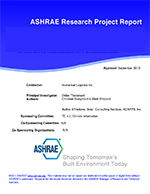-
-
Available Formats
- Options
- Availability
- Priced From ( in USD )
-
Available Formats
-
- Immediate download
- $16.00
- Add to Cart
Customers Who Bought This Also Bought
-

RP-173 -- Method of Evaluation Based on the Operating Cha...
Priced From $32.00 -

4489 -- Survey of Reliability and Availability Informatio...
Priced From $16.00 -

4469 -- A Simulation Study on the Energy Performance of P...
Priced From $16.00 -

4468 -- A Practical Device for Surface Tension Measuremen...
Priced From $16.00
About This Item
Full Description
The findings for nonuniform outlet flow properties in Part I were used to devise a simple method of in situ testing of rotary energy wheels in HVAC applications. This method uses only data taken at one angular position (i.e., 90º from the diameter seal line) for the supply and exhaust outlets. Using these data, the resulting calculated effectivenesses are within 5% for sensible, 7% for latent, and 5% for total effectivenesses of the standard test method results, while the ranges of uncertainties in these effectivenesses are 4.5% to 5.4%, 8.3% to 9.3%, and 5.6%to 7.6%for the cold and hot tests, respectively. The uncertainties are smaller than those presented in Part I where a larger array of data was used. It is concluded from these findings that field testing and monitoring of energy wheels can be achieved within uncertainty limits that are reasonable and sometimes within the ASHRAE Standard 84-1991R recommended limits but slightly larger than those that can be achieved by a test laboratory using four measuring stations. This paper discusses a set of steps for in situ performance testing of energy wheels.
Units: Dual





